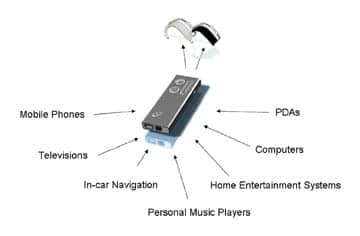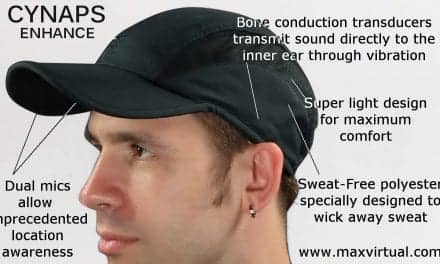Technological developments outside our industry are often the driving force behind advancements in hearing aid design, form, and function. As vacuum tubes, transistors, and then digital chips were incorporated within audio devices, hearing instrument technology developed in a parallel, albeit slightly delayed, manner. Ironically, the same advancements that serve to improve the quality of life for individuals with hearing loss can also create additional barriers. This becomes most evident when considering technologies such as mobile phones, televisions, and computers, which connect us to the “far world.”
For example, the use of digital technology in hearing aids has led to occlusion-free fittings, advanced noise-reduction algorithms, and automatic functioning. Incorporation of digital technology in mobile phones, however, has led to interference issues for many hearing aid users, often precluding the use of these two devices simultaneously. Workarounds are developed to address the issue, but the solutions are often complicated and cumbersome, making “Take out the hearing aid” the most attractive option. Kochkin1 reported that hearing aid users rate the use of mobile phones in conjunction with their hearing aids as the most troubling situation they face, with only 62% of all users reporting acceptable conditions in this scenario.
In an increasingly wireless world, individuals with hearing loss are faced with wearing hearing aids that do not easily interface with standard communication products—the devices and media most individuals take for granted. Unfortunately, in the development of hearing aids, access to far-world signals is often an afterthought. Solutions are typically reactive in nature, trying to make existing hearing aid technology “fit” with the new technology. Performance and convenience are unlikely to coexist with this approach.
Hearing Aid Connectivity
Epoq is the first hearing instrument built on Oticon’s RISE platform. This architecture was designed with connectivity as a core design feature. Incorporating earStream processing, communication between devices occurs at broadband speed. The Epoq hearing instruments can then work together, becoming one central processing unit. Going beyond simple binaural volume control and programming shifts, earStream technology allows the hearing instruments to share information at previously unseen speeds. Binaural signal processing algorithms that provide the user with a more natural and truer soundscape can be implemented. (See Schum2 for a detailed description of the RISE platform and processing of near-world sounds.)
The connectivity associated with these new hearing instruments increases exponentially when coupled with the Epoq Streamer device (Figure 1). The streamer serves as a gateway between the hearing instruments and devices with Bluetooth capability or an external audio port. Communication between the streamer and hearing instruments occurs wirelessly. The Epoq hearing instrument is designed to have the widest frequency response available, resulting in excellent sound quality for the end user. Importantly, the Epoq Streamer is intuitive and easy to operate, making it a viable option for most hearing aid users.

|
| FIGURE 1. Examples of far-world signals the Oticon Epoq Streamer can transmit to the Epoq hearing instruments. |
In summary, RISE represents a proactive approach to interfacing the hearing aid user with both near- and far-world sounds. It combines binaural communication with artificial intelligence to provide the listener with a rich soundscape that gives the user a sense of “place.” When combined with Streamer, Epoq users can also benefit from wireless streaming from audio devices such as mobile phones and personal stereo systems.
Binaural Signal Processing
In order to provide the individual with hearing loss a level playing field in terms of connectivity, the hearing instruments must incorporate the same technologies employed in communication devices used by normal-hearing individuals. The Epoq Streamer uses earStream processing that facilitates communication via wireless magnetic induction technology and Bluetooth technology. With earStream, the hearing instruments can communicate with each other at a rate of 120,000 bits per second—approximately 100 times faster than the best processing in the hearing care industry until now. With this binaural communication speed, the hearing instruments can move beyond basic coordination between devices to more advanced binaural signal processing and audio streaming in real time (Figure 2).

|
| FIGURE 2. Broadband speed communication between the new hearing instruments is designed to add capabilities not available in other hearing aids. |
This speed of communication allows Epoq to provide the brain with a truly binaural input. For far-world sounds, the Epoq Streamer provides the user with access to audio stream from virtually any device. Through Bluetooth or a wired connection, the Epoq Streamer can communicate with a large number of devices, which creates a personal area network (PAN). Magnetic wireless technology then allows the streamer to communicate with the hearing aids (body area network, or BAN).
Personal Area Network
The Epoq Streamer can connect wirelessly with devices capable of emitting a Bluetooth signal. Bluetooth technology is now incorporated into many devices including mobile phones, personal stereo systems, computers, and GPS systems. Bluetooth technology has evolved from a high-end feature only present on certain devices to an integral component of multimedia devices.
Bluetooth is a type of short-range wireless radio technology that shares some of the characteristics of an FM signal but with some important advantages. First and foremost, Bluetooth has been rapidly integrated into commonly used devices, making it an ideal technology to include in hearing devices. A Bluetooth signal is more secure than an FM signal, incorporating adaptive “frequency hopping” to increase the robustness of a signal while minimizing interference. Multiple individuals can be in the same room using Bluetooth communication without interference, since typically, each transmitting device is associated with one specific receiver. (Visit www.bluetooth.com for a detailed tutorial on Bluetooth technology and its applications.)
In order to communicate, the two Bluetooth devices (eg, Epoq Streamer and mobile phone) go through a simple, one-time pairing process. The communication connection can be one-way in nature, such as when the streamer receives a signal from a personal stereo, or two-way, as is the case with a mobile phone. In this scenario, the streamer receives the signal and also transmits the user’s voice to the phone.
Similar to an FM signal, Bluetooth can penetrate some barriers and does not require direct line of sight like an infrared signal. The Epoq Streamer can detect and transmit Bluetooth signals out to a distance of approximately 30 feet, making it useful for listening to music and other audio signals in a room. The individual’s PAN is approximately 700 square feet.
There are several Bluetooth profiles designed for specific uses (eg, simple commands, cell phone, high-quality audio, etc). The streamer is configured to accept all major Bluetooth profiles. Inexpensive adapters (or dongles) are widely available that can make the output from many audio devices Bluetooth compatible. In short, Bluetooth technology provides the user with wireless, high-quality audio transmission from just about any audio device. The streamer also has a 2.5 mm audio input jack should the user wish to interface via a wired connection (eg, if the external device is not Bluetooth compatible). Communication between the streamer and hearing device is wireless, making the Epoq hearing instruments a very small, wireless headset.
Body Area Network
While a Bluetooth signal is the primary means of communication between the streamer and various audio devices and mobile phones, another type of transmission is used for the wireless communication between the streamer and the hearing instruments. For communication within the BAN, near-field magnetic induction (NFMI) technology is employed.3 This technology is used for communication between Epoq hearing instruments (true binaural processing for near-world sounds) as well as between the hearing aids and the streamer.
Communication takes place via an interaction between two magnetic fields. The communication between the hearing aids is two-way. As with Bluetooth, this technology saw its first applications outside the hearing aid industry in devices such as hands-free mobile phone headsets and wireless two-way radio microphones. Also similar to Bluetooth, this technology exhibits a number of features that make it ideal for incorporation within hearing aids (Table 1).

|
| TABLE 1. Technologies used in the Oticon Epoq and Epoq Streamer in comparison to FM and induction technologies commonly employed in hearing devices. |
The components involved are extremely small, and the power needs are very low, which makes this technology possible within custom, behind-the-ear (BTE), and receiver-in-the-ear (RITE) hearing instruments. When implemented within the RISE platform, communication speeds are analogous to those obtained with cable Internet access. From a binaural processing standpoint, this allows for sharing of information between hearing aids at speeds that permit complex processing to maximize user understanding of near-world sounds. For far-world sounds, the high-quality audio signal received by the streamer is maintained when wirelessly transmitted to the hearing aids.
With NFMI, the transmitting device generates a small electromagnetic field that is sensed by the receiving device. For transmission of high-quality audio signals, the range is approximately 2 to 3 feet, well within the distance between the hearing instruments and the streamer. The rapid drop-off in signal beyond 1 meter facilitates secure communication and resistance to interference. Additionally, each set of Epoq hearing instruments is programmed to communicate with one specific streamer. Two Epoq users can be in the same room using their streamers without interference.
In summary, two wireless zones are created when using Epoq hearing instruments in conjunction with the streamer. Within the PAN, information from far-world audio sources is transmitted to the streamer via a wireless Bluetooth or a hardwired signal. From the streamer, the information is transmitted to custom, RITE, or BTE Epoq hearing instruments in high-quality audio. The hearing instruments serve as custom wireless headsets, and the user benefits from binaural, wireless transmission of signals. No longer do communication and multimedia technology represent a barrier for the hearing instrument user.
Examples of Using the Streamer
The potential benefits of the streamer can only be realized if the device is easy to use for both the patient and the dispenser. The streamer is lightweight and small, with clearly marked controls (Figure 3). All operations are completed via four buttons. Importantly, the user does not have to deal with making adjustments on both the hearing aids and the streamer. Once the streamer is activated, the controls on the hearing aids are disabled and volume changes are made on the streamer itself. Initiating or terminating a phone call is accomplished by push- ing a button. The rechargeable battery in the streamer can provide talk time similar to a mobile phone and 90 hours of operation when in standby mode.

|
| FIGURE 3. Functions of the controls and jacks on the device. |
The following examples will serve to demonstrate the process of connecting to two common far-world sources.
Receiving a phone call. The streamer is designed as an ideal solution for providing the individual with hearing loss access to hands-free mobile phone communication. As long as the streamer is turned on and the mobile phone is within range (approximately 30 feet), any call to or from the phone will automatically initiate communication between the streamer and Epoq hearing instruments (ie, the user will hear the telephone ringing through the hearing aids). By pressing the phone button on the Epoq Streamer, the call is initiated.
The incoming phone signal is transmitted to the hearing aids; the outgoing user’s voice is picked up and transmitted via the Epoq Streamer microphone. The call can be terminated by pressing the phone button again. The user can choose to receive both the phone signal and environmental surroundings (somewhat analogous to an M/T setting on a regular hearing aid) or choose to mute the hearing aid microphones by a long press on the audio button during the call. Once a call is terminated, the streamer signals the hearing aids to resume normal operation. Correct streamer position can be maintained by wearing the device using the supplied neck strap. Alternatively, the user can hold the streamer, keeping the microphone within 1.5 feet of his or her mouth.
Listening to multimedia. For listening from multimedia devices that are not Bluetooth compatible, the user can connect a cable from an audio-out jack directly to the streamer. Alternatively, an inexpensive Bluetooth adapter can often be purchased that will transmit a Bluetooth signal from the connected device. To establish streaming, the user simply pushes the audio button on the Streamer. This initiates communication, and in default mode, disables the hearing aid microphones. As with mobile phone operation, though, the user can choose to enable or disable the hearing aid microphones during streaming.
Device pairing. By entering the streamer serial number into Oticon’s Genie hearing aid fitting software, a link is established between that specific pair of Epoq hearing instruments and that Epoq Streamer. Establishing a connection between the streamer and a peripheral device, such as a mobile phone, is also straightforward. The peripheral device needs to be placed into pairing mode. This mode is typically reached via the device menu, and directions are available in the instruction manual.
For example, for a Treo 650 mobile phone, the following steps would be taken:
- Put the streamer in pairing mode via a long push of the Bluetooth button (rapid blue flashing);
- Select “Bluetooth” in the main menu of the phone;
- Select Bluetooth “On” and “Discoverable” if not on already;
- Select “Setup devices”;
- Select “Hands-free Setup”;
- The phone will search for nearby Bluetooth devices;
- Once it appears in the device list, choose “Streamer,” then
- Enter pass code “0000.”
Once established, the pairing procedure does not need to be repeated. From this point, any time a call is received by the Treo when in vicinity of the streamer with Bluetooth on, the streamer will automatically be activated and the signal transmitted to the hearing instruments.
While each phone and audio device can have different menu labels and steps for pairing, the basic procedure is similar among devices. Both the streamer and peripheral device need to be set to pairing mode. The peripheral device will search for a “partner,” and when the streamer is found, it should be selected. The same pass code “0000” (four zeros) is always entered. If a peripheral device is “discoverable,” then it can be found by the streamer. This feature may need to be turned on as part of the pairing process. Once the devices are paired, future connections can typically be configured to occur automatically (devices will link whenever they are in proximity to each other) or manually (user chooses when to have the peripheral device connect to streamer).
Oticon provides dedicated material and personnel to ensure dispensers are familiar with the basics of pairing the streamer and peripheral devices. Ideally, a patient will leave the audiologist’s office with the streamer already paired to his or her mobile phone and/or favorite Bluetooth-enabled audio device.
Priority Sequence
The Epoq Streamer can retain pairing data for up to eight devices. Since several of these devices may be located in the same area, a set of prioritization “rules” has been incorporated within the streamer. To avoid conflicts, the streamer operates on the following principles:

|
| “Hearing Aid Compatibility and Wireless Devices.” By David Seabury and Brian J. Hill, MA, MBA. April 2007 HR.
“Will Wireless ALD Hybrids Save the Hearing Industry?.” By David S. Jones. January 2006 HR. “Bluetooth Technology: Toward More Wireless Hearing Care Solutions.” By Brad Ingrao, MSEd. November 2005 HR. “Wireless Binaural Synchonization in Hearing Aids.” By Thomas Powers, PhD; and Pamela Burton, MA. January 2005 HR. |
- Signals from mobile phones are given the highest priority.
- Audio received from a wired connection has the second-highest priority.
- Audio received from a Bluetooth-enabled audio source (other than a mobile phone) is given the lowest priority.
In this scenario, if the streamer is plugged into a stereo and the user’s mobile phone rings, the music volume is lowered and connection to the phone automatically established. The user does not have to worry about missing incoming phone calls. Once a phone conversation is terminated, the user can press the audio button to re-establish connection to the stereo.
A New Age of Connectivity
The question is no longer, “Can my hearing aids connect with a given device?” Rather, the question is, “With which devices do I want my hearing aids to interface?” The Epoq Streamer represents a quantum leap forward in connectivity. This device provides the hearing instrument user with a gateway to external audio signals from mobile phones and other multimedia devices.
Several technologies are employed to overcome the barriers to far-world access associated with traditional hearing aids. Users of BTE, RITE, and custom Epoq hearing instruments can benefit from the streamer. The streamer option provides high-quality, secure access to far-world signals in a small package more likely to be associated with an iPod than to a hearing device. With intelligent design and automatic functioning, both dispensers and end users will find the Epoq Streamer easy to operate. And with a rechargeable battery capable of providing 4 to 5 hours of use, even those with high listening demands can feel secure knowing the streamer will meet their daily needs.
References
- Kochkin S. MarkeTrak VII: Customer satisfaction with hearing instruments in the digital age. Hear J. 2005;58(9):30-43.
- Schum D. Redefining the hearing aid as the user’s interface with the world. Hear J. In press.
- Aura Communications. Near-field magnetic communication properties. White paper. Available at: www.auracomm.com/Downloads/webwireless.pdf. Accessed April 4, 2007.





